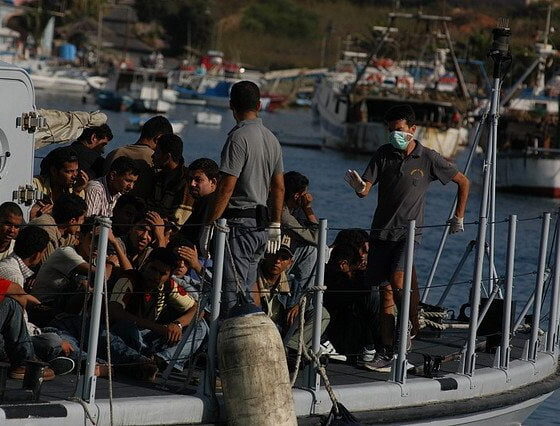

Environment
Campaigners call for climate refugee protection as migrant deaths reach record high
As a new study reveals that 22,000 migrants have died trying to reach Europe in the last 14 years, campaigners have warned that climate change may force many more to flee their country.
Blue & Green Tomorrow is currently running a crowdfunder to ensure its survival. Please pledge.
New figures from the International Organisation for Migration (IOM) reveal that 40,000 people have died on all migration routes since 2000, while crossing hazardous routes through deserts and oceans.
A record 4,077 have already died this year alone, most of them while crossing the Mediterranean. The dangers of this route were tragically demonstrated in 2013, when more than 400 migrants died in two separate shipwrecks near the Italian island of Lampedusa.
The report suggests that eight people die each day in the search for a better life, but the IOM fears even this startling figure may be an underestimate, because of a lack of information.
In the face of what appears to be a growing crisis, the report calls for a crackdown on smugglers and changes to migration laws to better protect these most vulnerable of people.
“Limited opportunities for safe and regular migration drive would-be migrants into the hands of smugglers, feeding an unscrupulous trade that threatens the lives of desperate people,” said IOM director general William Lacy Swing.
“It is time to engage the world to stop this violence against desperate migrants.”
Experts note that there is a vast range of reasons for migrants to flee their home countries. This year, it is believed the majority of those making the Mediterranean crossing are Syrian, escaping from the civil war.
However, in the wake of the IOM report, campaigners have called for more to be done to investigate the role climate change will play in driving people across borders.
Many poorer countries are more vulnerable to the impacts of climate change, as they lack the infrastructure or budgets to protect against them. Many such countries lie in regions of the world particularly exposed to the rising sea levels and weather extremes that rising temperatures are expected to bring.
Recent figures from the Internal Displacement Monitoring Center reveal that climate-related events force people from their homes on a scale that far outstrips displacement caused by conflict and persecution.
In February, Christiana Figueres, executive secretary of the UN Framework Convention on Climate Change, warned that unabated global warming could displace up to 1 billion people by 2050.
Steve Trent, executive director of the Environmental Justice Foundation, has argued that while the majority of today’s climate migrants do not leave their own countries, our understanding of these complex processes remains insufficient.
“At the turn of the next century, in a world which is two, three or four degrees warmer and where avenues for safe and regular migration remain closed, how will migration look? Over the coming decades, how many climate refugees might die attempting to reach sanctuary, build a better life for their children or support their families left behind in areas ravaged by climate impacts?” he told Blue & Green Tomorrow.
Trent notes that, for example, scientists have linked climate change to the extreme drought credited with sparking the Syrian conflict.
Such conditions are a threat elsewhere, and military analysts have previously warned that rising temperatures are likely to exacerbate tensions across the developing world.
As the factors that force people from their homes intensify, Trent, like the IOM, warns that restrictive migration policies are endangering lives.
“What is clear is that we urgently need to improve our understanding of how climate change exacerbates the factors which drive cross-border flows of undocumented migrants and, in particular, start to construct a legal and policy framework which protects the rights of those first-and worst-affected by climate change and ensures that they are able to move safely, positively and with dignity.”
The EJF is currently leading a campaign lobbying the UN to afford climate refugees special status and aid. Its postcards initiative encourages supporters to take a photo explaining what home means to them. Every image will be sent to the UN secretary-general Ban Ki-moon.
Photo: Noborder Network via Flickr
Further reading:
World Refugee Day: campaign demands help for ‘human face of climate change’
Mass migration and social unrest: why the west should care about climate change
Climate instability ‘will bring more Lampedusas’, UN warns
Lampedusa a ‘graveyard for migrants’ as hundreds die in boat tragedy
Climate change: it’s not just an environmental issue; it’s a human rights issue too


 Environment10 months ago
Environment10 months agoAre Polymer Banknotes: an Eco-Friendly Trend or a Groundswell?

 Environment11 months ago
Environment11 months agoEco-Friendly Home Improvements: Top 7 Upgrades for 2025

 Features9 months ago
Features9 months agoEco-Friendly Cryptocurrencies: Sustainable Investment Choices

 Features10 months ago
Features10 months agoEco-Friendly Crypto Traders Must Find the Right Exchange





























